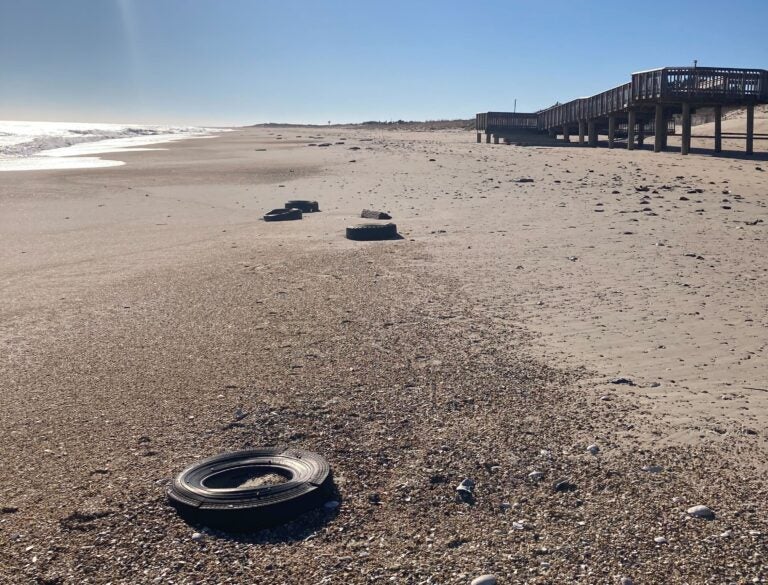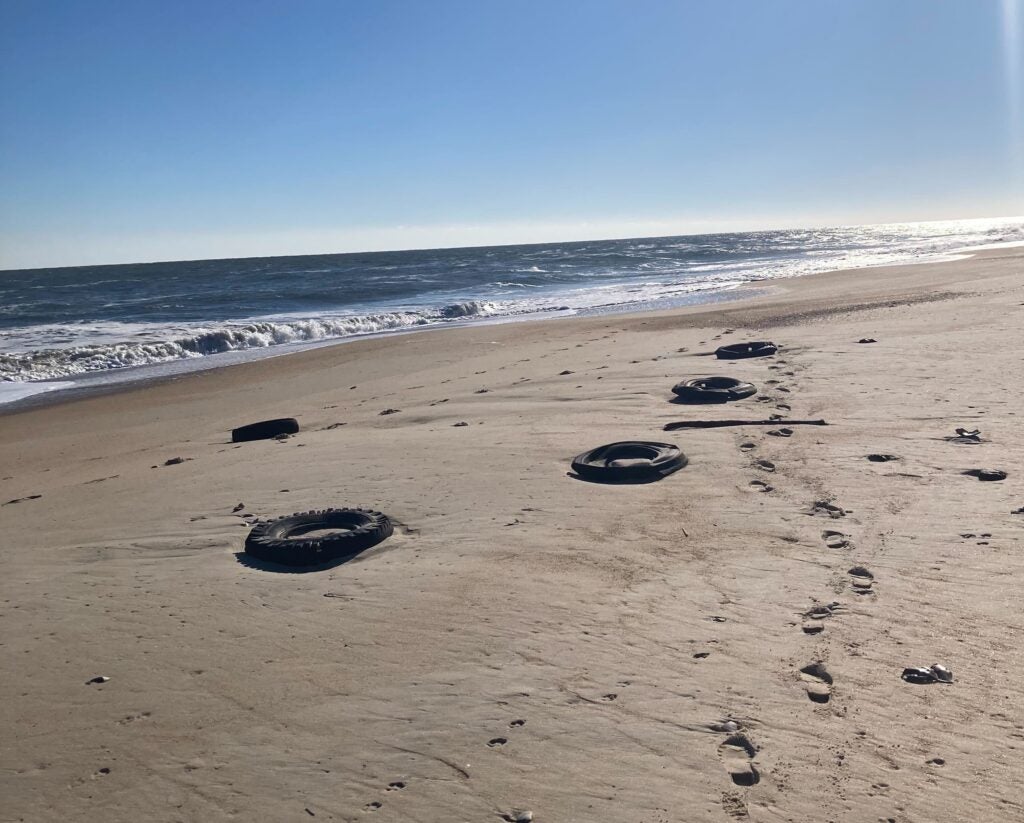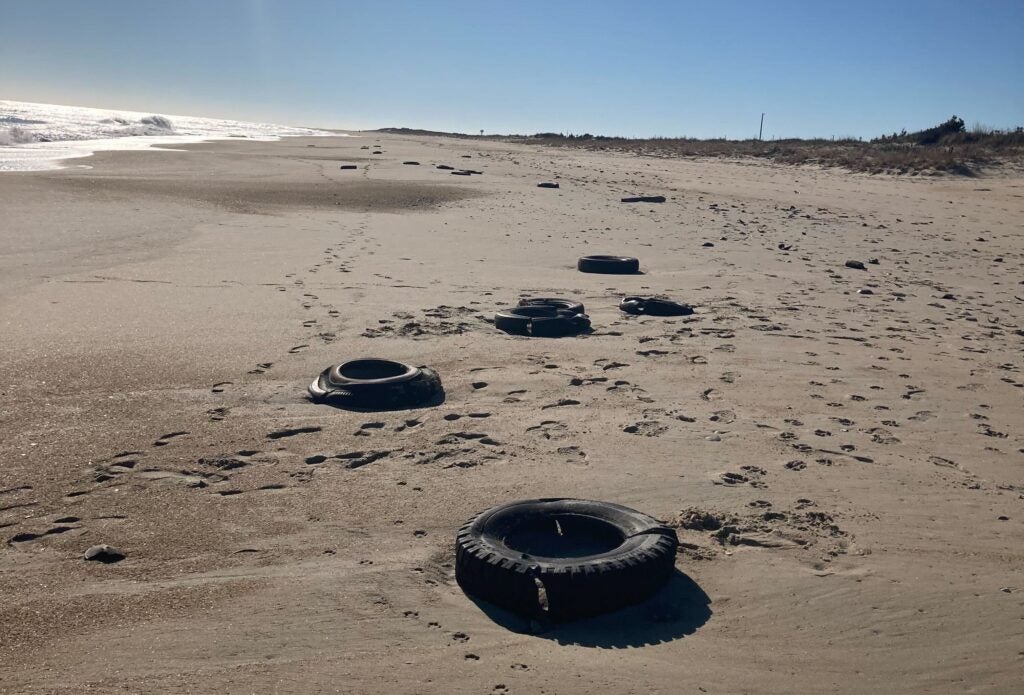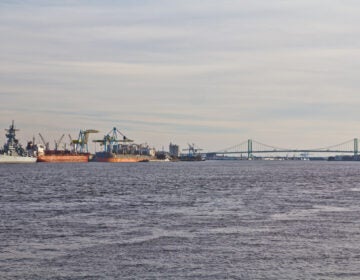More than 100 tires have washed ashore Delaware beaches since December
Delaware’s Department of Natural Resources and Environmental Control is investigating whether washed ashore tires came from decades-old artificial reefs.

Surfer Crystal Stokowski said she spotted dozens of tires while walking along the beach in Fenwick Island (courtesy of Crystal Stokowski)
From Philly and the Pa. suburbs to South Jersey and Delaware, what would you like WHYY News to cover? Let us know!
Crystal Stokowski was walking along Delaware’s Indian River Inlet in search of surfable waves when she came across dozens of tires lining the beach.
“You could see them all the way down, because it was on a lower tide. They’re regular car or truck tires. So they’re not hard to miss,” said Stokowski, a Rehoboth resident who has documented and cleaned beach debris over the past several years.
“You don’t want this going back in the water. And you have all these people that surf during the winter here, and it’d be awful to be surfing and seeing a tire come at you,” she said.

More than a hundred tires have washed ashore on Delaware beaches since late December, according to the state Department of Natural Resources and Environmental Control.
The agency has been investigating whether they drifted away from decades-old artificial reefs during recent heavy storms. Artificial reefs are made to improve fish habitat, enhance coastal erosion protection and provide marine research opportunities.
Evidence suggests the tires may have traveled from out-of-state, and DNREC continues to search for the source.
Tire sightings were first reported on Fenwick Island, and have since been discovered about 5 miles north in Bethany Beach. DNREC staff have been collecting the tires, which are then recycled.
“It is expected that more tires are likely to wash ashore after strong coastal storm events such as the state recently experienced,” the agency said in a statement.
The branding and styles of the tires suggest they may have come from an artificial reef built in the mid ‘70s or early ‘80s. During this time — and through the 1990s — car tires were commonly repurposed to build artificial reefs in the Mid-Atlantic, including in Delaware.
On Friday, SONAR scans confirmed the tires did not come from one of the state’s two tire reefs, as images showed they were intact. DNREC continues to investigate where the tires migrated from.
It’s not unusual for old tires — or even remnants of war — to degrade and wash ashore during storms, said Art Trembanis, a professor of oceanography and geology at the University of Delaware.
However, the abundance of tires recently discovered on Delaware’s beaches is alarming, he said.
“Sadly, I think what we’re seeing play out is the sins of the fathers are being brought on to our beaches — although, all well-intentioned at the time,” Trembanis said. “It’s a matter of trying to think of how far ahead is one really trying to consider our stewardship of the environment. I think we need to have a much longer viewpoint of that as we assess these kinds of programs.”

These man-made marine habitats can become marine debris during storms, and impact the environment, if not designed with sturdy materials.
“Smaller little tires are relatively light, so they’re going to tend to want to stay up on the surface, and then they’re going to get moved around by these waves and currents, and they’re going to take out everything in their path — and that means further disturbance to seabed environments,” Trembanis said.
Loose tires could also become a hazard for people swimming in the water, he added.
Small vehicle tires are no longer used for artificial reefs. Instead, agencies use industrial-sized tires that are weighed down with concrete, he said.
Other kinds of materials can prove just as hazardous. Following Hurricane Sandy in 2012, subway cars used as a part of an artificial reef site off the Delaware coast were smashed.
Artificial reefs have evolved over time, however, and agencies are beginning to use more environmentally-friendly materials, such as natural rock and concrete, Trembanis said.
DNREC said many of the tires it has collected have strap-like markings, suggesting they may have been tied with metal cable — a method Delaware never used, according to the agency. In Delaware, stacked tires filled with concrete were dropped onto the ocean floor as structures, DNREC said.
The last time the state’s reefs were surveyed, tires were in place and covered in coral, the agency said. However, DNREC is working to get updated imagery of its artificial reefs.
The agency also plans to get new SONAR scans of any debris fields in locations with tire reefs to help confirm the sources of the tires that washed ashore.
Although the source of the tires is still being investigated, illegal dumping is not suspected, DNREC said.
Trembanis advises residents and beachgoers to avoid touching the tires if they see them, because there may be wire, glass or other hazardous materials inside them. Instead, they should report the sighting to DNREC, he said.

Get daily updates from WHYY News!
WHYY is your source for fact-based, in-depth journalism and information. As a nonprofit organization, we rely on financial support from readers like you. Please give today.






